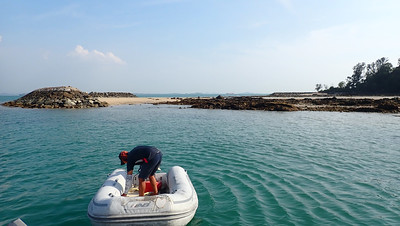It was great to see the coastal forests here are still thriving. As well as living sandy shores, rocky shores and lots of soft corals on the shore facing Kusu Island. The rest of the team also saw cone snails, nudibranchs and other interesting marine life.
There are not a lot of hard corals on this shore, as it has been on our past surveys.
But there was a good variety of hard corals. I didn't see any that were bleaching.
On the rocky shore, Jianlin Liu saw 2 cone snails and a small abalone. The Burrowing giant clam there is still doing well.
The shore facing Kusu Island didn't have many hard corals, but there were a lot of flowery soft corals today - Asparagus flowery soft corals and Spiky flowery soft corals. There were also some small Leathery soft corals. I saw many Red feather stars, and several small Spider conch snails. One was laying eggs. On the survey, I only saw one Giant carpet anemone and one Frilly anemone. I didn't see any Haddon's carpet anemones.There were large sandy patches on the shore too. Taking a closer look, there were lots of signs of life in the sand.
These were full of Cake sand dollars, many Oval moon snails and signs of Acorn worms. I also saw one Common sea star, one Garlic bread sea cucumber and many signs of sand burrowing crabs.My most important stop was to check on the coastal forest. Lazarus Island has some of the best large wild coastal forests in Singapore. Many of our coastal forest plants are Critically Endangered because we have so few of these natural coastlines left undeveloped. I last surveyed this forest in 2011 and in 2013. So it was nice to see some familiar plants are still there.
I last saw the Critically Endangered Bonduc (Caesalpinia bonduc) in 2013. is a very prickly bad-tempered plant! Its fierce hooks will catch onto clothing (or bare skin!) and are hard to dislodge. There are only a few plants known in the wild in Singapore. So it was a little disturbing to see that much of the leaves on the plant was eaten up by some insect. (But the hooks were still very much there and it still grabbed me even though I was careful). The one on Lazarus is a male plant, I have seen the female plant on Pulau Semakau.
It was good to see the Pelir musang (Fagraea auriculata) found here are still doing okay. Another Critically Endangered coastal plant, the huge flowers are said to be 30cm across and 'Pelir musang' means 'civet cat's testicles' in Malay, probably referring to the fruits. Other interesting trees include a large Brown-scurfy fig, and a Sea almond tree that fell over but continued growing by putting out side branches that are now small trees! There was also a tree with a metal tag on it, which means its a rare tree. But I don't know what it was. I'm amazed at how the tree clings onto the cliff face.
The seagrass situation seems alright. On Lazarus Island, I saw sprinkles of Spoon seagrass with tiny leaves, and a small patch of Smooth ribbon seagrass. I didn't see as much seagrass in the Seringat-Kias lagoon as in but perhaps because the tide wasn't low enough to expose the seagrasses. But I did see lots of Needle seagrass with narrow leaves, some growths of Smooth ribbon seagrass at the low water mark, and floating in the water, lots of broken Noodle seagrass leaves. I also saw a small clump of Tape seagrass with long leaves, and a small clump of Serrated ribbon seagrass.
There is still a bloom of Bryopsis seaweed on the shore, this seems to be perpetual these days on many of our shores. In the Seringat-Kias lagoon, I didn't see signs of a seaweed bloom though. And the Sargassum has died out.
We also checked on the Seringat-Kias lagoon. Alex informed us this is also called Eagle Bay by boaters. The tide wasn't very low by the time we arrived. The seagrasses are okay, and Jianlin saw a boxfish here!
Today, I finally made it to this shore because we landed directly from the boat on the shore (Thanks to Alex and James!). Usually, it is a very long walk to and from the shore if we use the main jetty. So I leave it to the rest of the team to survey while I just lamely do the shores nearer the jetty. Today is the last evening low spring tide. The tides are not low enough in March. We resume with predawn surveys in April. Catching up on sleep while we can!
The southern shore of Lazarus that we surveyed today has seawalls. But this is minor compared to the massive reclamation that created Seringat-Kias, which buried the submerged reefs of Seringat and Kias and connected it to the natural Lazarus Island. A causeway bridge joins these with St. John's Island. Here's more about what was done to create Seringat-Kias.
Lazarus Island in the Singapore Blue Plan
The cluster of Kusu, Lazarus and St. John's Islands has been recommended by the Singapore Blue Plan 2018 for elevated protection status.
The Blue Plan highlights that Lazarus, St. John’s, and Kusu Islands are established sites for coral nurseries as their shoreline offers ideal sheltered areas for growth of corals. Designating these islands as No-fishing Areas can bolster their rehabilitation. Protecting a larger cluster of islands means zonation plans for use can be implemented to manage tourism and human impacts.
DOWNLOAD the Plan, SUPPORT the Plan! More on the Singapore Blue Plan 2018 site.
Photos by others on this trip
Russel Low
Nathaniel Soon
Richard Kuah
James Koh on flickr.














